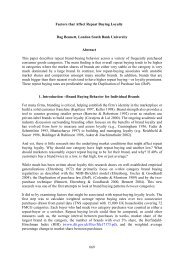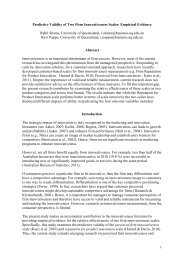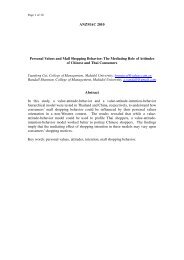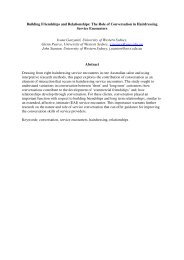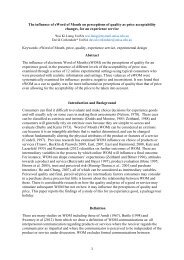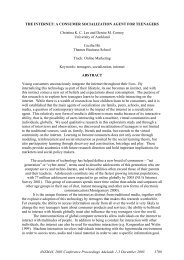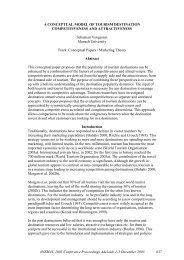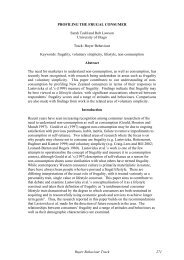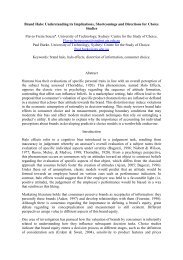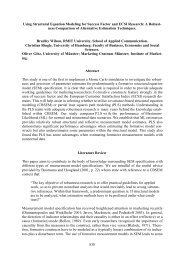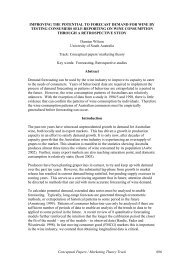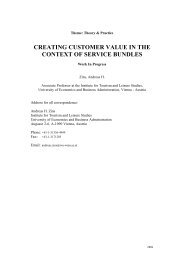amj Australasian Marketing Journal - ANZMAC
amj Australasian Marketing Journal - ANZMAC
amj Australasian Marketing Journal - ANZMAC
Create successful ePaper yourself
Turn your PDF publications into a flip-book with our unique Google optimized e-Paper software.
their clothes provides a deeper understanding of the dynamics<br />
of consumer behaviour and the nature and role of the product<br />
category of fashion clothing in society. Relevant to this study<br />
is the view that involvement may be understood via<br />
consumer-fashion clothing attachment or relationships. It is<br />
this attachment and its relationship to self-monitoring and<br />
materialism that is important.<br />
Browne and Kaldenberg (1997) gathered data from 387<br />
respondents within an age spectrum of younger people<br />
(students), aged 18-49. The study tapped self-monitoring<br />
using Snyder s (1987) scale, Richins and Dawson (1992)<br />
material values scale and Laurent and Kapferer (1985)<br />
consumer involvement profile. Browne and Kaldenberg<br />
(1997) found that respondents degree of self-monitoring,<br />
materialism and involvement differed by age and gender.<br />
They also found that materialism varied by self-monitoring<br />
(high-low). Further, they also indicated self-monitoring was<br />
related to fashion clothing involvement. Finally they indicated<br />
that the data supported the proposed relationships between<br />
materialism and fashion clothing involvement. Importantly,<br />
Browne and Kaldenberg (1997) seem to have based the<br />
proposed relationships on product involvement, however they<br />
also mention purchasing involvement in one section of their<br />
discussion. So it is not completely clear, how they defined and<br />
used involvement in their study. They do however, problematically<br />
identify that in their view the scale (Laurent &<br />
Kapferer, 1985) measures antecedents of involvement and not<br />
actually involvement. The focus of their measure appears to<br />
be both at the product and brand level and its focus is not on<br />
involvement per se, but antecedents, which has caused some<br />
concerns in the literature (Mittal & Lee, 1988; O Cass,<br />
2000a). Therefore, there is a need to examine these issues and<br />
focus on a clear and sound approach to involvement, materialism<br />
and self-monitoring.<br />
3. Study Objectives<br />
The relationship between self-monitoring and other key<br />
consumer characteristics that affect marketplace behaviour,<br />
are relatively unexplored at this stage in consumer research.<br />
This study explores the relationships between self-monitoring,<br />
materialism and fashion clothing (product) involvement<br />
and purchase decision involvement and fashion consumption<br />
motives that are oriented toward the symbolic, enhancement<br />
of the self, hedonic and functional. The study also examines<br />
gender and age related effects on materialism, involvement<br />
and self-monitoring.<br />
Whilst research on the diffusion of innovations is plentiful<br />
and is rich and varied in orientation, that focusing on the fashion<br />
innovator has concentrated mainly on demographics and<br />
life style. While such demographic and lifestyle information<br />
has been very useful for classification purposes they provide<br />
little insight into the factors affecting purchase decisions. The<br />
purpose of this study is to extend this stream of research by<br />
developing and testing a model that describes the critical<br />
Fashion Clothing Involvement<br />
characteristics of fashion involved. Specifically, this research<br />
postulates that the key determinants of fashion involvement<br />
are the existence of a self-monitoring personality and materialistic<br />
values. Also, the model suggests that the fashion<br />
involved will apply a particular set of motives when thinking<br />
of fashion clothing, image and pleasure.<br />
4. Hypothesised Relationships<br />
Given the above discussion it is argued that there should exist<br />
gender and age related effects on self-monitoring, materialism<br />
and involvement as previously identified by Browne and<br />
Kaldenberg (1997) and Auty and Elliott (1998) and Bloch<br />
(1981). Also Browne and Kaldenberg (1997) stated that based<br />
on the presumed association between materialism and valuing<br />
publicly consumed goods, it was anticipated that higher levels<br />
of self-monitoring would be associated with a value system<br />
that was more materialistic. Browne and Kaldenberg (1997)<br />
also proposed strong relationships between self-monitoring<br />
and involvement. Further, on this issue Auty and Elliott<br />
(1998) argued that self-monitoring can be seen as a surrogate<br />
for involvement, implying a strong relationship exists.<br />
Further, materialism is also thought to affect consumers<br />
involvement, therefore materialism should have a significant<br />
positive effect on fashion clothing involvement and fashion<br />
clothing purchase decision involvement. Also given the<br />
nature and symbolic content of fashion clothing it is believed<br />
that social and pleasure motives will be positively related to<br />
fashion clothing involvement, and that functional motives<br />
will be negatively or not related to fashion clothing involvement.<br />
As discussed above, a strong image orientation is said<br />
to be a defining characteristic of both self-monitors and materialists<br />
therefore, it is thought that self-monitoring will be<br />
positively related to social and pleasure motives for fashion<br />
clothing consumption. A value system that is more materialistic<br />
will also be positively related to social and pleasure<br />
motives and negatively related to functional motives for fashion<br />
clothing consumption. These relationships are expressed<br />
in Figure 1.<br />
The importance of the present study is that both materialists<br />
and high self-monitors are considered to be opinion leaders<br />
and consumption prone and as such, these are characteristics<br />
of important market segments. Understanding such relationships<br />
could provide and important basis for psychologically<br />
grounded benefits-based promotions targeting consumer characteristics<br />
via specifically designed and targeted marketing<br />
mix strategies. There is also a considerable economic and<br />
social side to fashion clothing consumption. Such important<br />
social and economic issues warrant research and justify the<br />
present study.<br />
5. Data Collection Method<br />
A questionnaire was developed that included measures of<br />
fashion clothing involvement (product and purchase decision)<br />
(O Cass 2000a), a measure of self-monitoring (O Cass,<br />
<strong>Australasian</strong> <strong>Marketing</strong> <strong>Journal</strong> 9 (1), 2001 49



